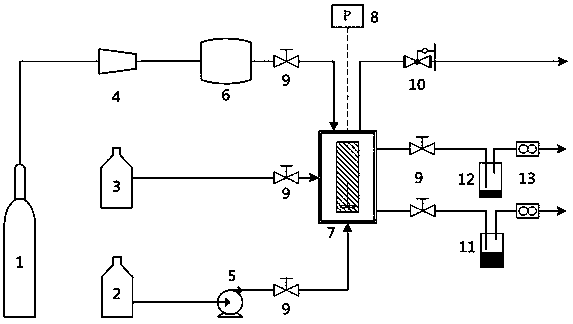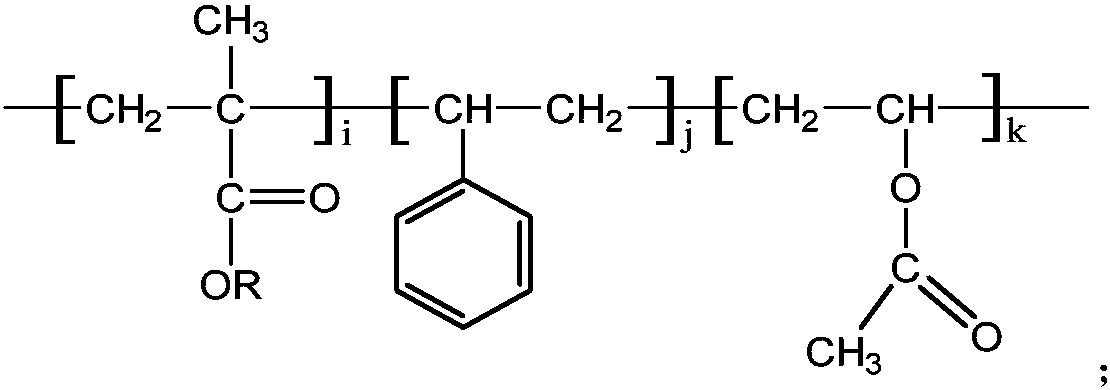Chemical additive for improving recovery ratio of high-deep thickened oil CO2 gas flooding process
A technology of chemical additives and oil recovery, which is applied in the direction of chemical instruments and methods, drilling compositions, etc., can solve the problems of difficult oil recovery, unsatisfactory results, and viscous crude oil, etc., to achieve enhanced heavy oil recovery, Good solubilization and viscosity reduction properties, the effect of reducing the viscosity of heavy oil
- Summary
- Abstract
- Description
- Claims
- Application Information
AI Technical Summary
Problems solved by technology
Method used
Image
Examples
Embodiment 1
[0018] Embodiment 1 prepares chemical additive and measures its viscosity-reducing performance
[0019] The chemical additive is composed of a solubilizer propyl p-methoxybenzoate and a viscosity reducer lauryl methacrylate-styrene-vinyl acetate copolymer, and the mass ratio of the two is 4:1. Add the solubilizer and the viscosity reducer into the beaker, stir at room temperature for more than 1 hour to make them fully mixed, and then the chemical additives are obtained.
[0020] The preparation method of the viscosity reducer lauryl methacrylate-styrene-vinyl acetate copolymer is as follows: in a 150ml three-necked bottle equipped with a mechanical stirrer and a condenser tube, add 80ml of toluene as a solvent, and then add total The amount is 10g, and the molar ratio is 10:8:1 methyl methacrylate, styrene and vinyl acetate, and the initiator azobisisobutyronitrile of 5% of the total weight of raw materials, generally N 2 After replacing the air in the bottle, stir and reflu...
Embodiment 2
[0026] Embodiment 2 tests chemical additive to promote CO 2 Solubility in heavy oil
[0027] Devices used such as figure 1 Shown, used chemical additive is consistent with embodiment 1. The airtightness of the instrument needs to be checked before the experiment, and CO is introduced into the autoclave 2 , kept at 25MPa for 2h, if the pressure fluctuation does not exceed 1%, it can be considered that the airtightness is good. During the experiment, first weigh 25g of heavy oil in the balance kettle, turn on the CO 2 Injection valve and gas phase sampling valve, with 100 ~ 200ml / min of CO 2Air purging for 10 minutes, the air in the kettle was exhausted, and then all valves were closed. Turn on the constant temperature water bath, increase the pressure to 15MPa, stir and balance for more than 1 hour to achieve gas-liquid equilibrium. After that, slightly open the liquid phase sampling valve, take out about 20mg of liquid phase sample, and measure the amount of released gas...
Embodiment 3
[0030] Embodiment 3 prepares chemical additive and measures its performance
[0031] The chemical additive is composed of a solubilizer propyl p-methoxybenzoate and a viscosity reducer stearyl methacrylate-styrene-vinyl acetate copolymer, and the mass ratio of the two is 4:1. Add the solubilizer and the viscosity reducer into the beaker, stir at room temperature for more than 1 hour to make them fully mixed, and then the chemical additives are obtained.
[0032] The preparation method of the viscosity reducer stearyl methacrylate-styrene-vinyl acetate copolymer is as follows: in a 150ml three-necked bottle equipped with a mechanical stirrer and a condenser tube, add 80ml of toluene as a solvent, and then add total The amount is 10g, and the molar ratio is 10:8:1 methyl methacrylate, styrene and vinyl acetate, and the initiator azobisisobutyronitrile of 5% of the total weight of raw materials, generally N 2 After replacing the air in the bottle, stir and reflux at 70°C for 8 h...
PUM
 Login to View More
Login to View More Abstract
Description
Claims
Application Information
 Login to View More
Login to View More - R&D
- Intellectual Property
- Life Sciences
- Materials
- Tech Scout
- Unparalleled Data Quality
- Higher Quality Content
- 60% Fewer Hallucinations
Browse by: Latest US Patents, China's latest patents, Technical Efficacy Thesaurus, Application Domain, Technology Topic, Popular Technical Reports.
© 2025 PatSnap. All rights reserved.Legal|Privacy policy|Modern Slavery Act Transparency Statement|Sitemap|About US| Contact US: help@patsnap.com



